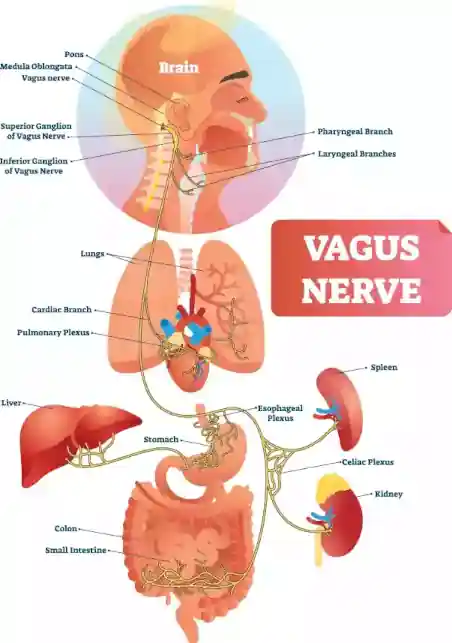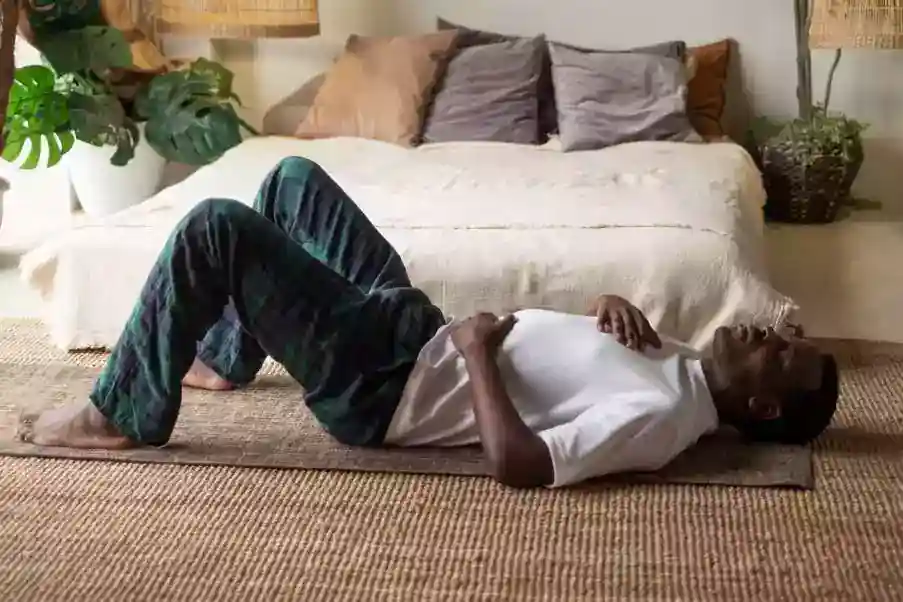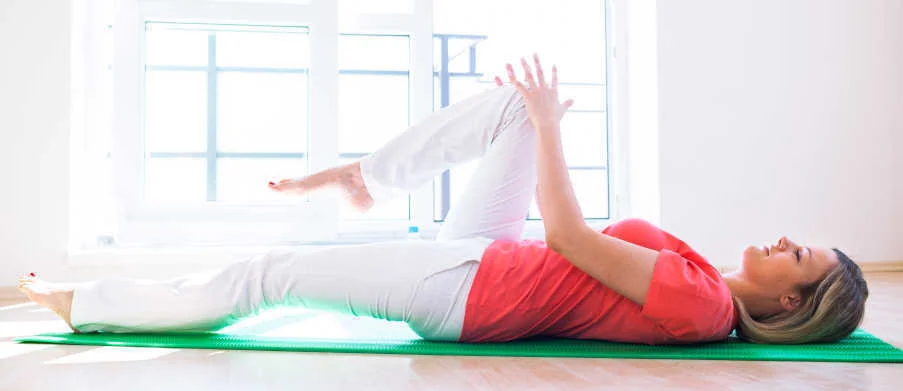Rest & Digest: The Vagus Nerve, Yoga And Wellbeing
Hot Air Or Cool Science?
Yoga is a popular form of exercise that has been shown to regulate the stress response with health benefits including reduced anxiety, optimization of vital functions such as blood pressure and digestion, and even enhancing immunity and calming the body’s inflammatory response
How does developing greater resilience to stress bring about so many benefits on so many levels? A major key is the Vagus Nerve, a pivotal mind-body link involved in down-regulating the body’s stress response and a major pathway for yoga-mediated relaxation
Dubbed by some “superhighway to health”, and “physical manifestation of the soul”, the Vagus is presented as a veritable holy grail for realizing your dreams and achieving health and happiness. But is such enthusiasm justified, or is it so much hype? What does science tell us about the function of the vagus nerve?
In this article, we’ll explore the structure, function and science of the Vagus nerve and explore how yoga, breathing and mindfulness practices can steer the body towards rest-and-digest to help you cope with stress and boost your physical, emotional and spiritual well-being
Understanding the Mind-Body Connection
The mind-body link is a pivotal aspect of our physiology and essential for optimal functioning and well-being. There is the intricate relationship between our thoughts, emotions, and physical health.
When we experience not just stress and anxiety, but also positive motions like love and joy, it affects not only our mental state but also our physical body. The mind and body are not separate entities but rather interconnected systems that influence one another. Mind and body are connected via three major pathways:
The (Autonomic) Nervous System, itself divided into a sympathetic fight-flight, and a parasympathetic rest-and-digest portion
The Hormonal (Endocrine) System
The Immune System
Each has a crucial role to play in protecting you against danger, injury and disease
Stress and anxiety gear the body for action, quickening the pulse, agitating the breath raising the heart pressure and generally diverting blood from the vital organs to the muscles of movement, and is mediated by the fight flight (or fight fright) activity of the Sympathetic Nervous System
The perception of safety is an essential condition for your body to rest, digest and generally replenish spent resources. This parasympathetic activity is distributed to the body at large through a number of nerves, the principal one being the Vagus Nerve.
Introducing The Vagus Nerve
The vagus is a paired nerve originating in the brain stem and descending through the neck and trunk to supply target organs from the throat all the way to the pelvis.
Also known as the “wandering nerve,” the Vagus is the longest cranial nerve in our body, extending from the brain-stem down to the abdomen and pelvis, and is responsible for regulating various bodily functions. Through its extensive network of branches, the Vagus links the brain with the vital organs, including the heart, lungs, and digestive system.
The Vagus exclusively parasympathetic. It is a mixed nerve carrying
- motor fibres to the muscles for voice and eating, notably swallowing and gagging
- parasympathetic rest-and digest fibres to most internal organs. Parasympathetic activity is a powerful anti-stress mechanism helping your body recover from a stressful event or period
- and sensory fibres relaying information about the state of the internal organs to the brain. The vagus is the major part of the gut-brain axis, an important pathway for emotional regulations and gastrointestinal health
It’s important to mention that the Vagus is not itself the source of rest-and-digest activity, but rather a cable linking the brain to the target organs through bidirectional electrical signals. To understand the Vagus and harness its healing power it’ll be helpful to take a closer look at the autonomic nervous system
Understanding The Autonomic Nervous System
Though the nervous system is an undivided whole, it is convenient when studying it to break it down into component parts. A major classification divides the nervous system into
- a voluntary or somatic component dealing with voluntary movements and conscious perception
- and an autonomic nervous system (ANS) involved in regulating involuntary internal functions essential for life, such as your heart rate, digestion, and breathing
The ANS itself can be further divided into a:
- Sympathetic – fight & flight which, together with cortisol, a hormone released from brain, constitutes the stress response to situations deemed to be challenging
- Parasympathetic – mediating relaxation, or rest and digest when the perception of safety is uppermost
- And a third, freeze reaction. Considered our most primitive form of self-preservation, freezing is a response to the terror of sensing extreme danger, and is a factor in trauma and post traumatic stress disorder (PTSD)
Note that the safety linked rest-and-digest and terror driven freeze reactions are both mediated by the Vagus. One nerve, two very different functions originating in different brain regions
Autonomic Tone
The autonomic nervous system is a single integrated system concerned with regulating those essential life-preserving activities that lie (largely) outside of voluntary control. Sympathetic and parasympathetic activity work together in a synergistic way to provide an autonomic tone appropriate for any given situation
Vagus Nerve: Basic Anatomy And Functions
The Vagus exits the brain-stem in the lower posterior part of the cranium, descending into the neck, and travelling down to be distributed to the organs of the neck, chest, abdomen and pelvis

The Vagus is a mixed nerve, being:
- 80% sensory and 20% motor
- sensory components include include pain sensitivity and interoceptive (see below) sensations from the organs, such as hunger, thirst, fullness and satiety
- its motor functions include control of the voluntary muscles for voice and involuntary muscles associated with eating, notably swallowing and gagging
- it is the principal carrier of rest and digest signals from the parasympathetic nervous system to your internal organs
Rest and digest actions of the Vagus nerve on key organs
- HEART – slows down heart rate, lowers blood pressure
- LUNGS – calms the rate and depth of breathing
- GUT – stimulates digestion, absorption and intestinal transit
- SPLEEN – supports immunity; lowers inflammation
Safety, Social Engagement And The Vagus
As stress mobilizes your body’s resources into quick action to deal with a challenge, rest allows your body to replenish its resources
Rest-and-digest parasympathetic activity predominates when you perceive being in a safe environment or situation
The Vagus is also involved in social social engagement. According to the Polyvagal Theory proposed in 1994 by Stephen Porges, professor of psychiatry at the University of North Carolina, safety is the condition for social behaviour to take place in mammals. Eating with friends and family, sharing stories, giving and accepting support and cooperating with your work team are expressions of social engagement.
Think Mediterranean lifestyle: extended mealtimes, outdoor socializing, a clear distinction between work and leisure. It’s not just what you eat, but also how you eat it that lets you rest and digest
Freeze Reactions, Trauma And The Vagus
The Sensory Vagus: Interoception And Emotional Regulation
The vagus is 80% sensory. It’s repertoire includes the sensation of pain, as well as being the main pathway for interoception: your brain’s ability to listen to the state of your internal organs
A relatively “newly” recognized sense, interoception refers to your ability to sense your inner body. Hunger, thirst and satiety are examples of consciously accessible interoceptive sensations. Interoception is strongly linked with emotional regulation, and engaging with your body’s internal state has been shown to help you manage stress & anxiety and enjoy a felt sense of wellbeing
The Vagus In Health And Disease
By controlling rest-and-digest activity in the body, the Vagus is essential for homoestasis – the maintenance of a stable internal environment.
The Vagus is a major part of the gut-brain axis, linking gastro-intestinal function to emotional regulation and wellbeing
Vagal activity suppresses the release of inflammatory mediators, notably tumor necrosis factor-alpha (TNFα) from the Spleen to exert a powerful anti-inflammatory effect (Buric 2017)
Hardly surprising then that Vagal activity is associated with improved mental health, from PTSD to anxiety and depression, as well inflammatory disorders including inflammatory bowel disease (Bonaz 2017), arthritis and psoriasis. It plays a significant role in cardiovascular and gastrointestinal health
Parasympathetic Vagal activity strengthens the immune system, and may even have an significant role in the management of cancer
Vagus nerve stimulation has been postulated as a potential adjunctive treatment for cancer. Animal studies have found a reduction in tumour size following vagus nerve stimulation. A systematic review by De Couck, et al. (2018) of studies on human cancer patients found a positive correlation between Vagal activity and prognosis (expected outcome). The strength of the association was especially marked in patients with metastatic spread of the disease
The Vagus Nerve And Yoga
Yoga is in essence a holistic mind-body therapy integrating posture and movement with breath-work and mindful awareness to help you become centered, tranquil and happy. Researchers have linked all the major physical and mental health benefits to yoga’s contemplative dimension of yoga, with the parasympathetic nervous system and Vagus as principal mediators (Gerritsen 2018, Sullivan 2018)
Nevertheless, there is some evidence supporting the idea that some yoga postures and breathing exercises can mechanically stimulate the vagus within the abdomen, chest and neck to bring about measurable parasympathetic effects
Vagus Nerve Stimulation With Yoga
The Vagus Nerve can be stimulated electrically by means of an external device: electrical stimulation of the parasympathetic Vagus has been shown to slow heart-rate, relieve pain and reduce inflammation. It has also been successfully used to relieve some cases of depression. Though the procedure also has several potential applications, Vagal electrical stimulation is currently licensed solely for managing treatment-resistant epilepsy and depression
Yoga may directly stimulate the Vagus in a variety of ways, including breathing techniques and postures which mechanically stimulate the abdomen, chest and neck
Though rigorous studies are lacking, there is some preliminary evidence that breathing exercises (pranayamas) and postures (asanas) which stimulate the abdomen, chest and neck give immediate responses indicative of parasympathetic activity. Commonly recommended exercises include
- Kapala Bhati (Shining Skull) and Bhastrika (Bellows) breathing
- Chest opening back-bends such as the Cobra (Bhujangasana), Camel (Ustrasana) and Bow (Dhanurasana)
- Inversions such as shoulder (Salamba Sarvangasana) and head stand (Shirshasana)
Mechanical stimulation of the vagus nerve via yoga poses, though immediate, is also transient, leading some to doubt its usefulness. Nevertheless, it may be a useful short-term tool for getting a grip quickly in situations of high stress or anxiety
Conclusion
Electrical stimulation of the Vagus Nerve can be graduated to specifically target the parasympathetic Vagus with a number of positive effects
Yoga and other exercises may mechanically stimulate the Vagus, but no volume control exists for specifically targeting the relaxation response (remember the Vagus is polymodal)
Though it has a element of physical exercise, yoga can be more accurately described a holistic mind-body therapy integrating posture and movement with breath-work and mindful awareness to help you become centered, tranquil and happy.
Researchers have concluded that the observed health benefits of yoga are primarily linked to its contemplative dimension, with the parasympathetic nervous system and Vagus as principal mediators (Gerritsen 2018, Sullivan 2018)
Yoga And Cardiovascular Health
Research shows that yoga improves the major predictors of cardiovascular disease and stroke. Regular yoga practice lowers your blood pressure, improves blood cholesterol profile, raising good and lower bad cholesterol levels, and down-regulates inflammation, a major factor in blood vessel damage and fat deposition (Cramer 2014)
Yoga And Inflammation
A 2017 systematic review of MBIs (Buric 2017) showed that mindfulness, yoga, Tai Chi, Qigong, relaxation and breath regulation all produced a down-regulation of inflammation at the gene level. Inflammation is strongly linked to stress and is a major cause of the blood vessel damage leading to fat deposition and narrowing
Numerous systematic reviews have found yoga to be helpful in maladies from back pain, arthritis, fibromyalgia and chronic pain, to migraine, tension headaches, asthma, irritable bowel and mental health, including major depressive disorder
Click the link to read more about the health benefits of yoga
Practical – Vagus Nerve Yoga
Yoga has been shown to have a positive impact on vagus nerve function, leading to improved health and well-being. Yoga breathing and relaxation techniques help activate the parasympathetic relaxation response, promoting a positive feeling of calm and relaxation to stimulate the vagus nerve. Additionally, some yoga poses, such as backbends and inversions help stimulate the vagus nerve and improve its function in the short term. By incorporating yoga into your daily routine, you can help support your vagus nerve and promote better health and well-being
Let’s put theory into practice with some yoga exercises to help you stay chilled and on the ball – in all weathers

Posture, Safety And The Vagus
Posture & Emotion
The posture of fear resembles a tortoise hiding its shell: the trunk is tense, the head and extermities pulled in; the breath is held; a small noise can make your knees give way – or turn you into a hare as you make a dash for it
The posture of safety is a different tortoise: the trunk is relaxed, the limbs strong, the head emerges, the senses look outward and the breath flows
Here in this most fundamental of yoga postures – Tadasana, the mountain – we’ll use the force of gravity to stimulate postural reflexes which signal safety to the vagus
The exercise is also a great way to establish the fundamentals for practising all standing postures
Standing Firm: Tadasana, The Mountain Pose
- Stand with your feet at hips’ width apart. Notice the turn-out (or in) of your feet. The population-average for neutral is your second toe pointing forward. Find your comfortable balance between habit and correct. This is your functional neutral. Do this for each foot. Don’t worry if your feet aren’t totally symmetrical
- Distribute your weight evenly over the heels and bases of the little and big toes
- Pull your knees back to lock them straight. Do you feel the reaction at the pelvis? The pelvis tends to roll forward, the lower back hollows, and maybe your tummy juts forward
- Now, keeping your knees straight let them just relax forward. Feel the base of the spine (sacrum) release down and under? Does your tummy relax back in?
- Alternate between relaxing and locking your knees a few times, noticing the effects on your posture
- This time try simply pressing your feet into the ground. Straight down. Firmly. Notice the muscles of the legs and trunk activate? Is there less of a tendency for your bottom to stick back and your belly forward? Let yourself relax
Now we’ve done all that doing, let’s do a bit of undoing
- Noticing your body weight over your heels, connect with the feeling of pressure. Let your heels sink into the ground, your knees straight, but unlocked
- Maybe you feel the leg muscles begin to activate? If you’re not sure, press your feet down. Firmly. Then relax, and let them once again drop
- Can you feel your pelvis rotate backwards as your feet sink, your tail dropping down and tucking under, your pubic bone floating up and back? Maybe you feel the pelvis float up a little, away from the feet?
- Do you feel your navel float naturally backwards? You’ve just activated, or rather disinhibited the transversus muscle, the deepest layer of abdominal support
- Now, let’s transfer the awareness up to the head: imagine your head as a ball, the top of your neck a bowl of water. Let the head float on the water
- With your your gaze forward at eye level, let your head roll on the water so your chin relaxes backwards, towards the top of your throat, and the space between the back of your head and neck opens and softens. You’re still looking forward, not down
- Can you feel the crown of the head float up and slightly back?
- Now that your head is free, you can let your neck hang from your head; then allow your upper and middle back, rib cage, shoulders and arms to hang from the neck; now let your lower back hang from your middle back; your pelvis and legs drop from the lower back; your feet sink into the ground
- Let your head float; allow your feet to drop; linger a while; enjoy
Breathing Calm: Pranayama For The Vagus Nerve
Experimentally and practically, breathing always comes up trumps as a way to connect with the rest-and-digest functions of the vagus
Science loves breathing: it’s quantifiable, practicable and reliably parasympathetic, as evidenced in a recent systematic review entitled: “How Breath-Control Can Change Your Life” (A Zaccaro et al, 2018)
Yoga loves breathing: breath is the primary expression of vital energy in the body. Prana, the vital force of yoga is indistinguishable from the Qi of Chinese medicine. Prana is the living energy we know as health, the spark that animates the body and lights up the mind. When prana moves the mind is thinks and feels. When prana is still the mind is at peace
The exercises below will help you make full use of the breath by allowing the air to fill every available part

The diaphragm is the main muscle of breathing. I’ll be sharing information on the anatomy and functions of the diaphragm in a separate post.
Just as when lifting your arm you’re following an intention to reach for something, not consciously activating the anterior Deltoid muscle, so when you breathe diaphragmatically you follow a set of intentions. Let me show you what I mean
Yoga Breathing Exercise For Vagus Nerve Stimulation – Side Breathing
- Place your hands over the front of the sides of your lower ribs. Rest your elbows on the ground and keep your hands separate
- Mentally place a 2lb weight on the underside of the navel. As you inhale your belly will rise, but that little bit of resistance will helps drive the air sideways into the lower ribs. Can you feel that? Your hands resting on the lower ribs will be your guide.
- Practice taking long, slow outbreaths. At the end of each exhalation wait for the inbreath to start naturally. Let the lower side ribs accept the air as above, then let the breath go slowly and quietly. Practice this for a minute or two

Yoga Breathing Practical For Vagus Nerve Stimulation – Back Breathing
Now, lie on your front, legs extended or flexed in the child’s pose as per the picture. Support your head if you need to, resting your forehead on your hands or a rolled up blanket
- With pressure on your belly, where does the air go when you inhale? Maybe some of it goes into the upper chest. that’s OK. Does some of the air fill the sides of the lower ribs? That’s even better
- You can if you want to, place the back of one hand over the lower ribs at the back. Can you allow this area to accept the breath? Try it on the other side
- Enjoy exhaling long, soft and for a minute or so
Inhabiting Your Body – Mindful Embodiment For Emotional Wellbeing
This simple, yet powerful body scan is a pure body meditation derived from an ancient Buddhist tradition, allegedly taught by the Buddha himself
The last of our three yoga practices for vagus nerve stimulation, this meditation helps you enjoy calm here and now through a felt sense of you own body. There is nothing to do but relax and observe
Sit or lie comfortably in a quiet space. Hit the play button. And enjoy
References
- A Systematic Review of Gene Expression Changes Induced by Meditation and Related Practices. I Buric, et al. 2017
- The Vagus Nerve in the Neuro-Immune Axis: Implications in the Pathology of the Gastrointestinal Tract. B Bonaz et al. 2017
- The Role of the Vagus Nerve in Cancer Prognosis: A Systematic and a Comprehensive Review. M De Couck et al. 2018
- Vagus Nerve as Modulator of the Brain–Gut Axis in Psychiatric and Inflammatory Disorders. S Breit et al. 2018
- The Vagus Nerve And The Inflammatory Reflex—linking immunity and metabolism. V A Pavlov, K J Tracey. 2012
-
Breath of Life: The Respiratory Vagal Stimulation Model of Contemplative Activity. R J S Gerritsen. 2018
- Yoga Therapy and Polyvagal Theory: The Convergence of Traditional Wisdom and Contemporary Neuroscience for Self-Regulation and Resilience. M B Sullivan et al. 2018
- A systematic review of yoga for heart disease. H Cramer et al. 2014
Related Posts
Visit Extremadura, Spain’s Best Kept Secret
Occupying the south western corner of the central Iberian plateau, Extremadura, the place beyond the Duero river, is a land of great natural beauty and cultural richness, a place of contrasts – and extremes!
Yoga Nidra: 10 Ways To Boost Your Physical And Mental Health
Nidra is an ancient yoga practice of deep relaxation, to help you release tension and stress and leave you refreshed, and able to deal with life’s challenges.
What Is Yoga Nidra? Discovering An Ancient Practice For Modern Times:
from stress-management and better sleep to reducing blood pressure and boosting digestion, learn can how Yoga Nidra can help you
The Meaning Of Yoga: Origins, Philosophy And Practice
integrate yoga into your mat work and your daily life for deep and lasting changes

